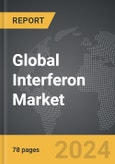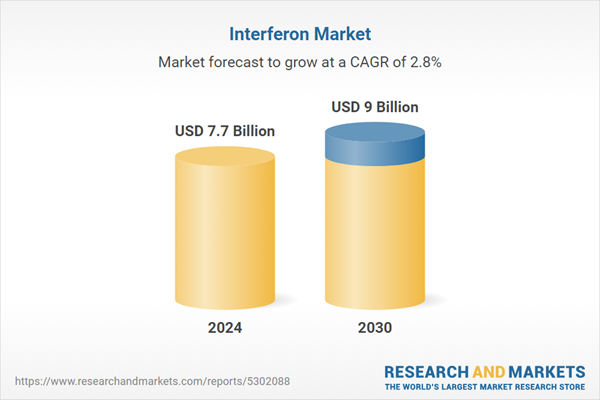Global Interferon Market - Key Trends and Drivers Summarized
What Is Interferon and How Does It Work in the Body?
Interferon is a group of signaling proteins, naturally produced by the body, that play a crucial role in the immune system's defense against viruses, bacteria, and cancer cells. These proteins are part of the cytokine family, and they help regulate the activity of the immune system by signaling neighboring cells to initiate their defense mechanisms. When a cell is infected by a virus, for example, it releases interferons to alert nearby cells to heighten their antiviral defenses, essentially creating a barrier to prevent the spread of the infection. Interferons also activate immune cells like macrophages, natural killer cells, and T lymphocytes, which work to eliminate infected or cancerous cells from the body. There are three main types of interferons - alpha, beta, and gamma - each with different roles and applications in medical treatments. Interferon-alpha is widely used in the treatment of viral infections, such as hepatitis B and C, while interferon-beta is primarily used to manage multiple sclerosis by reducing the frequency and severity of flare-ups. Interferon-gamma is often used in the treatment of chronic granulomatous disease and other immunodeficiencies, where it enhances the body's ability to fight infections. The ability of interferon to modulate the immune response makes it a powerful tool in managing diseases that are otherwise difficult to treat.How Has Interferon Evolved as a Therapeutic Tool in Modern Medicine?
Since its discovery in the late 1950s, interferon has evolved significantly as a therapeutic agent, undergoing extensive research and clinical trials to understand its full potential. Initially, its antiviral properties made it a promising candidate for treating viral infections, and by the 1980s, recombinant DNA technology allowed for the mass production of synthetic interferons, which could be administered as drugs. This development led to the approval of interferon-based therapies for conditions like hepatitis B and C, where they helped reduce viral load and slow disease progression. Interferon-alpha, in particular, became a standard treatment for chronic hepatitis infections, significantly improving patient outcomes before the development of direct-acting antivirals. Interferon's role has since expanded into oncology, where it is used to treat certain cancers, such as malignant melanoma and kidney cancer. Its ability to stimulate the immune system to recognize and attack cancer cells has made it a valuable component of immunotherapy regimens. In the realm of autoimmune diseases, interferon-beta has transformed the management of multiple sclerosis, where its immune-modulating effects help prevent the inflammation and demyelination that lead to the neurological damage seen in MS patients. The evolution of interferon as a drug has been marked by ongoing innovations, including the development of pegylated interferons, which have longer half-lives and require fewer injections, improving patient adherence and quality of life.How Is Interferon Changing Patient Outcomes Across Different Medical Fields?
Interferon's broad therapeutic applications have had a significant impact on patient outcomes, particularly in the treatment of viral infections, cancer, and autoimmune diseases. In the field of infectious diseases, interferon-alpha has been a critical tool in the fight against hepatitis B and C. Before the advent of newer antiviral therapies, interferon was one of the few available treatments that could reduce viral replication and prevent liver damage, leading to improved long-term survival rates for patients. Even today, in combination with other antivirals, it remains a useful therapy in certain contexts. Interferon-beta's impact on multiple sclerosis has been transformative, offering patients a way to manage their symptoms and slow the progression of the disease. By reducing the frequency of relapses and minimizing the development of new lesions, interferon-beta has significantly improved the quality of life for many MS patients. In oncology, interferon has shown promise in treating cancers such as malignant melanoma, where it is used as an adjuvant therapy to boost the immune system's ability to fight off cancer cells. Interferon's ability to stimulate an anti-tumor response has made it a part of certain immunotherapy strategies, particularly in cases where other treatments may not be as effective. However, despite its benefits, interferon therapy can also come with significant side effects, such as flu-like symptoms, fatigue, and depression, which can limit its use for some patients. Nevertheless, ongoing research into refining interferon treatments and combining them with other therapies continues to improve outcomes across various medical fields.What Are the Key Growth Drivers of the Interferon Market?
The growth in the interferon market is driven by several key factors, each of which is contributing to the increasing demand and development of interferon-based therapies. One of the primary drivers is the rising incidence of chronic viral infections, particularly hepatitis B and C, which continue to affect millions of people worldwide. Although newer direct-acting antivirals have revolutionized the treatment of hepatitis C, interferon remains a relevant option, especially in resource-limited settings where access to more expensive therapies may be limited. Another critical growth driver is the increasing prevalence of autoimmune disorders, particularly multiple sclerosis, where interferon-beta remains a cornerstone of treatment. As the global population ages, the incidence of autoimmune conditions like MS continues to rise, driving demand for interferon therapies. Additionally, the growing field of cancer immunotherapy is fueling interest in interferon's role as an adjuvant treatment in oncology. Its ability to enhance the body's immune response against certain types of cancer, including melanoma and renal cell carcinoma, makes it a valuable part of multi-modal cancer treatments. Technological advancements in drug formulation, such as the development of pegylated interferons, are also boosting the market by improving patient compliance and reducing side effects, making interferon therapy more accessible and tolerable for long-term use. Lastly, the expansion of research into new therapeutic applications for interferon, including its potential role in treating emerging viral threats and chronic diseases, is expected to further drive market growth in the coming years. As the demand for effective, immune-modulating treatments continues to rise, the interferon market is poised for sustained development across multiple medical fields.Report Scope
The report analyzes the Interferon market, presented in terms of market value (US$ Thousand). The analysis covers the key segments and geographic regions outlined below.- Segments: Type (Interferon Beta, Interferon Alfa, Other Types).
- Geographic Regions/Countries:World; United States; Canada; Japan; China; Europe (France; Germany; Italy; United Kingdom; Spain; Russia; and Rest of Europe); Asia-Pacific (Australia; India; South Korea; and Rest of Asia-Pacific); Latin America (Argentina; Brazil; Mexico; and Rest of Latin America); Middle East (Iran; Israel; Saudi Arabia; United Arab Emirates; and Rest of Middle East); and Africa.
Key Insights:
- Market Growth: Understand the significant growth trajectory of the Interferon Beta segment, which is expected to reach US$4.6 Billion by 2030 with a CAGR of a 3.1%. The Interferon Alfa segment is also set to grow at 2.6% CAGR over the analysis period.
- Regional Analysis: Gain insights into the U.S. market, valued at $2.1 Billion in 2024, and China, forecasted to grow at an impressive 4.3% CAGR to reach $1.8 Billion by 2030. Discover growth trends in other key regions, including Japan, Canada, Germany, and the Asia-Pacific.
Why You Should Buy This Report:
- Detailed Market Analysis: Access a thorough analysis of the Global Interferon Market, covering all major geographic regions and market segments.
- Competitive Insights: Get an overview of the competitive landscape, including the market presence of major players across different geographies.
- Future Trends and Drivers: Understand the key trends and drivers shaping the future of the Global Interferon Market.
- Actionable Insights: Benefit from actionable insights that can help you identify new revenue opportunities and make strategic business decisions.
Key Questions Answered:
- How is the Global Interferon Market expected to evolve by 2030?
- What are the main drivers and restraints affecting the market?
- Which market segments will grow the most over the forecast period?
- How will market shares for different regions and segments change by 2030?
- Who are the leading players in the market, and what are their prospects?
Report Features:
- Comprehensive Market Data: Independent analysis of annual sales and market forecasts in US$ Million from 2024 to 2030.
- In-Depth Regional Analysis: Detailed insights into key markets, including the U.S., China, Japan, Canada, Europe, Asia-Pacific, Latin America, Middle East, and Africa.
- Company Profiles: Coverage of players such as AbbVie, Inc., Anavex Life Sciences Corp., Baxter International, Inc., Bayer AG, Biocon and more.
- Complimentary Updates: Receive free report updates for one year to keep you informed of the latest market developments.
Some of the 12 companies featured in this Interferon market report include:
- AbbVie, Inc.
- Anavex Life Sciences Corp.
- Baxter International, Inc.
- Bayer AG
- Biocon
- Biogen
- Eli Lilly
- F. Hoffmann-La Roche Ltd.
- Genentech
- GlaxoSmithKline
This edition integrates the latest global trade and economic shifts into comprehensive market analysis. Key updates include:
- Tariff and Trade Impact: Insights into global tariff negotiations across 180+ countries, with analysis of supply chain turbulence, sourcing disruptions, and geographic realignment. Special focus on 2025 as a pivotal year for trade tensions, including updated perspectives on the Trump-era tariffs.
- Adjusted Forecasts and Analytics: Revised global and regional market forecasts through 2030, incorporating tariff effects, economic uncertainty, and structural changes in globalization. Includes historical analysis from 2015 to 2023.
- Strategic Market Dynamics: Evaluation of revised market prospects, regional outlooks, and key economic indicators such as population and urbanization trends.
- Innovation & Technology Trends: Latest developments in product and process innovation, emerging technologies, and key industry drivers shaping the competitive landscape.
- Competitive Intelligence: Updated global market share estimates for 2025, competitive positioning of major players (Strong/Active/Niche/Trivial), and refined focus on leading global brands and core players.
- Expert Insight & Commentary: Strategic analysis from economists, trade experts, and domain specialists to contextualize market shifts and identify emerging opportunities.
Table of Contents
Companies Mentioned (Partial List)
A selection of companies mentioned in this report includes, but is not limited to:
- AbbVie, Inc.
- Anavex Life Sciences Corp.
- Baxter International, Inc.
- Bayer AG
- Biocon
- Biogen
- Eli Lilly
- F. Hoffmann-La Roche Ltd.
- Genentech
- GlaxoSmithKline
Table Information
| Report Attribute | Details |
|---|---|
| No. of Pages | 153 |
| Published | December 2025 |
| Forecast Period | 2024 - 2030 |
| Estimated Market Value ( USD | $ 7.7 Billion |
| Forecasted Market Value ( USD | $ 9 Billion |
| Compound Annual Growth Rate | 2.8% |
| Regions Covered | Global |









